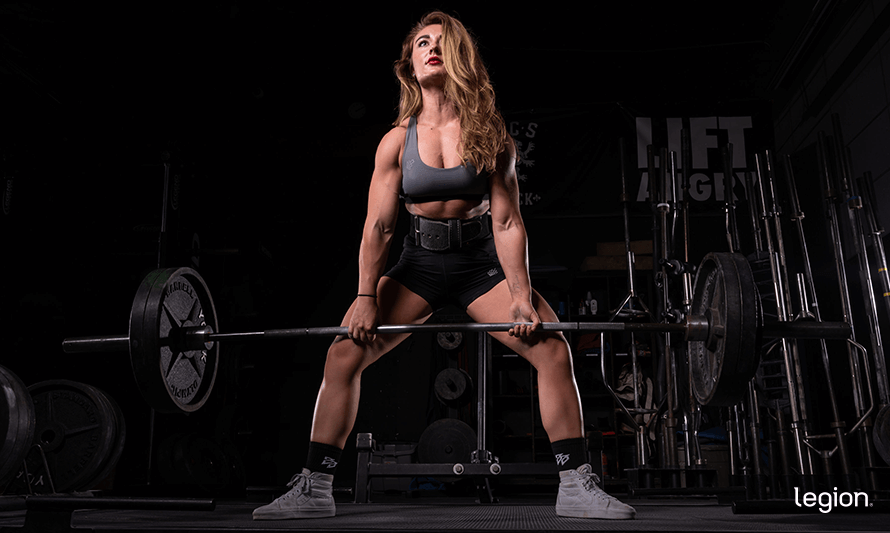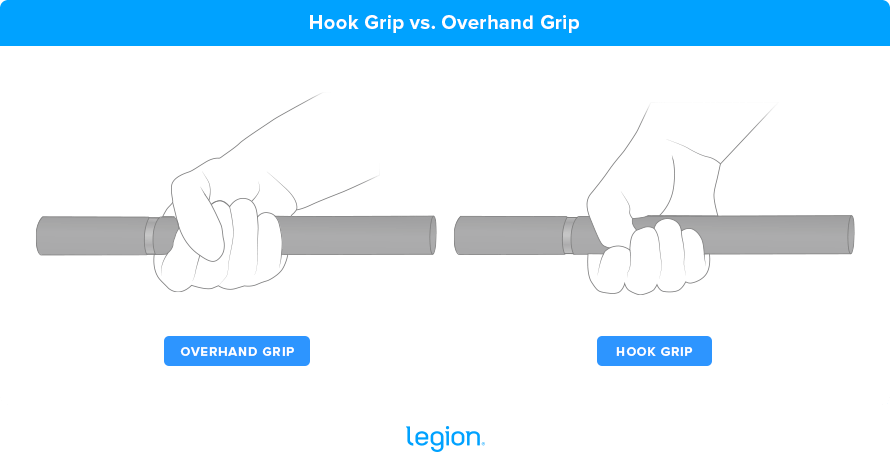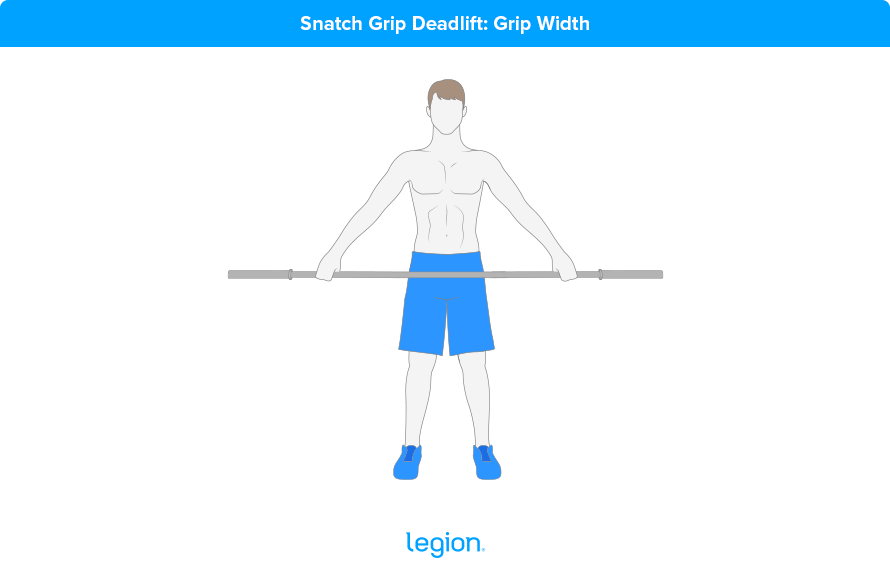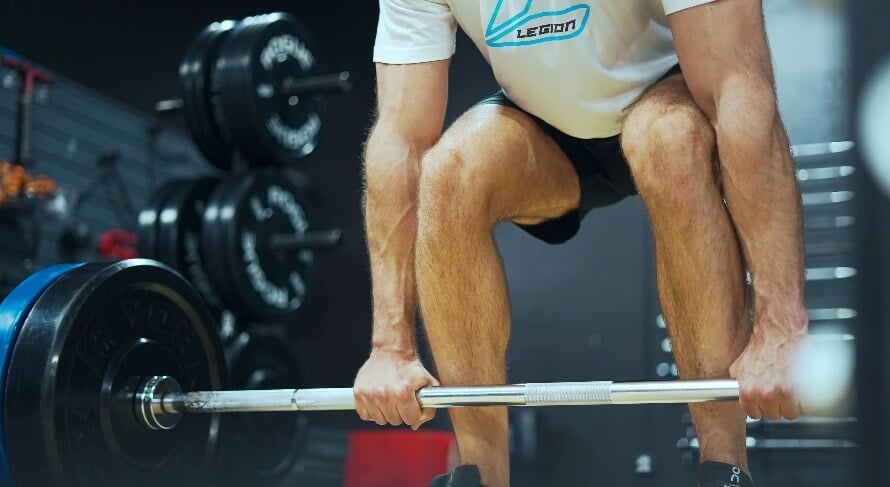The Ultimate Guide to Deadlift Grip Types
You’ve been stuck at the same deadlift weight for weeks.
Your back feels strong, your legs are ready to lift heavier, but every time you go for a new max, the bar slips out of your hands.
Sound familiar?
If so, you’re probably dealing with a deadlift grip issue.
Grip strength is one of the most overlooked factors in deadlift performance. It’s often the reason why some deadlifters can pull heavy weights for rep after rep, while others struggle to break the bar off the floor.
In this guide, you’ll learn everything you need to know about deadlift grips—from choosing the best type of grip for your goals to mastering techniques that will help you hold the bar longer and more securely.
Key Takeaways
- The best deadlift grip depends on your goals, preferences, and circumstances—no single grip works for everyone.
- Deadlift grip types like the overhand, mixed, hook, snatch, and fat grip each have unique benefits and drawbacks.
- A strong grip is crucial for deadlifting; it can be the difference between hitting a PR and your hands giving out.
- To improve your deadlift grip strength, deadlift regularly, avoid straps on other exercises, do grip-specific training, and use chalk when needed.

- Overhand Grip Deadlift
- Mixed Grip Deadlift
- Hook Grip Deadlift
- Snatch Grip Deadlift
- Fat Grip Deadlift
- How to Improve Your Grip Strength for the Deadlift
- FAQ #1: What’s the best grip for the deadlift?
- FAQ #2: Hook grip vs. Mixed grip: Which is better?
- FAQ #3: Is the mixed grip deadlift bad?
Table of Contents
+Overhand Grip Deadlift
The overhand grip deadlift involves holding the barbell with both palms facing your body. It’s the simplest and most natural grip, which is likely why it’s often the first deadlift grip beginners use.
Here’s how the overhand grip deadlift looks:
Benefits of the Overhand Grip Deadlift
- Improves Grip Strength: In the overhand grip deadlift, the bar rests entirely in your fingers and gets no assistance from any other part of your hands. The downside of this is that it’s usually the weakest type of deadlift grip. That said, it also forces you to strengthen this weak point, which can greatly improve your deadlift grip strength over time.
- Encourages Symmetry: Unlike other deadlift grip types, the overhand grip keeps both arms symmetrical, which reduces the odds you’ll develop muscle imbalances or suffer an injury.
- Simple to Learn: The overhead grip deadlift is usually where new deadlifters start because it’s the simplest grip to grasp. For many, it’s also the most comfortable.
How to Set Up Your Grip for the Overhand Grip Deadlift
- Place your feet slightly narrower than shoulder-width, with toes pointed out.
- Position a barbell about an inch from your shins over your midfoot.
- Take a deep belly breath, and grip the bar just outside your shins with palms facing you.
- Nestle the bar as close to the bottom of your fingers and top of your palms as possible, and squeeze as hard as you can.
Mixed Grip Deadlift
The mixed grip deadlift goes by many names, including the “switch grip deadlift,” “alternate grip deadlift,” and “reverse grip deadlift.” Despite the different terms, they all describe the same technique: a deadlift performed with one palm facing your body and the other facing away.
The mixed grip significantly improves your grip strength because the opposing hand positions create a locking effect on the bar. As the bar tries to roll out of one hand, it’s secured by the other, making it much easier to hold heavy weights without slipping.
However, the mixed grip comes with notable downsides. First, it positions your arms asymmetrically, which can lead to muscle imbalances over time.
Second, the underhand grip (palm facing away) places the biceps in a vulnerable position. If you don’t keep your arms straight or jerk the bar as you lift the weight, the added tension on the underhand arm can strain or even tear the biceps.
Here’s how the mixed grip deadlift looks:
Benefits of the Mixed Grip Deadlift
- Strengthens Your Grip: Switching to a mixed grip instantly increases your deadlift grip strength compared to the overhand grip deadlift, allowing you to lift much heavier weights without your grip becoming the limiting factor.
- Uses No Equipment: Using a mixed grip for the deadlift boosts your grip strength without having to use extra equipment, such as deadlifting straps.
- Easy to Learn: Compared to other types of deadlift grip, the mixed grip is simple to learn and, when done correctly, doesn’t cause discomfort.
How to Do the Mixed Grip Deadlift
- Place your feet slightly narrower than shoulder-width, with toes pointed out.
- Position a barbell about an inch from your shins over your midfoot.
- Take a deep belly breath, and grip the bar just outside your shins with your non-dominant hand facing you and your dominant hand facing away.
- Nestle the bar as close to the bottom of your fingers and top of your palms as possible, and squeeze as hard as you can.
Hook Grip Deadlift
Using a hook grip for the deadlift involves gripping the bar with both palms facing your body, but instead of wrapping your fingers around the bar as usual, you trap your thumb underneath your fingers. This creates a secure “hook” that makes it harder for the bar to slip from your hands, even when lifting heavy weights.
At first, the deadlift hook grip can feel uncomfortable—even painful—due to the pressure on your thumbs. However, with consistent practice, your thumbs adapt, and the discomfort diminishes over time.
Here’s how it looks compared to the overhand grip deadlift:

Benefits of the Hook Grip Deadlift
- Increases Grip Strength Without Equipment: The hook grip locks the bar in place without needing straps or other grip aids, so it’s perfect for those who prefer to train “raw” (without assistive gear).
- More Symmetrical Than Mixed Grip: Unlike the mixed grip, the hook grip keeps both hands oriented in the same way, reducing the risk of muscle imbalances or uneven stress on your shoulders and back.
- Stronger Than Overhand Grip: The hook grip prevents the bar from rolling out of your hands, allowing you to hold onto the bar more easily than the regular overhand grip.
How to Do the Hook Grip Deadlift
- Place your feet slightly narrower than shoulder-width, with toes pointed out.
- Position a barbell about an inch from your shins over your midfoot.
- Take a deep belly breath, and wrap your thumbs round the bar while slightly internally rotating your arms (turning them so that the backs of your hands face each other).
- Lock your hands in place by wrapping your fingers over your thumbs and externally rotating your arms until your palms face you again.
Snatch Grip Deadlift
The snatch grip deadlift is a deadlift variation that uses a wide grip commonly seen in Olympic weightlifting. Using a snatch grip increases the distance the bar must travel to complete a rep, making the exercise more challenging for your legs, back, and grip.
You find the right width for your snatch grip by standing upright and holding a barbell at a width that places it in your hip creases when your arms are straight. Here’s an illustration to help you visualize this:

The snatch grip deadlift can be a useful “accessory exercise” to enhance your deadlift performance and back strength. However, it’s not ideal as your primary deadlift variation because the snatch grip limits how much weight you can lift.
In other words, use the snatch grip deadlift to complement your main deadlift work, not replace it.
Here’s how it looks:
Benefits of the Snatch Grip Deadlift
- Greater Leg Invovement: The wide grip increases the exercise’s range of motion, which forces your legs to work harder than they do in a conventional deadlift. This extra challenge makes it excellent for building lower body strength.
- More Upper Back and Forearm Engagement: The wider grip also increases the load on your upper back, forearms, and lats, which makes it particularly useful for building back strength and improving grip.
- Increased Deadlift Strength: By effectively increasing your range of motion of each rep, you force your posterior chain to work harder through what’s typically the most challenging portion of a deadlift: getting the bar off the floor. By strengthening your body in this position, you generally find your conventional deadlift numbers increase when you return to regular pulling.
How to Do the Snatch Grip Deadlift
- Stand gripping an empty barbell at a width that places it in your hip creases while your arms are straight. Mentally note this width or use the barbell’s knurling as a reference.
- Place the bar on the floor and load it with weights.
- Place your feet slightly narrower than shoulder-width, with toes pointed out.
- Position the barbell about an inch from your shins over your midfoot.
- Take a deep belly breath, and grip the bar with a snatch grip (overhand or hook) and your palms facing you.
Fat Grip Deadlift
To perform the fat grip deadlift, you attach rubber grips around the barbell that increase the diameter of the handle. This makes the bar significantly harder to hold, forcing your grip and forearms to work much harder than they would with a standard barbell.
Many companies make fat grip attachments, but having tested several of them, Fat Gripz is the brand I’d recommend.
RELATED: The Ultimate Guide to the Best Grip Strengtheners (2024)
Here’s how the fat grip deadlift looks:
Benefits of the Fat Grip Deadlift
- Builds Grip Strength: The larger bar diameter challenges your grip far more than a standard bar, which greatly strengthens your hands and forearms.
- Increases Forearm Development: By increasing the workload on your grip, fat grip deadlifts are highly effective for building forearm size and strength.
- Improves Performance on Pulling Exercises: A stronger grip ensures your hands can hold on longer during pulling exercises, allowing you to train the target muscles without your grip giving out prematurely.
How to Do the Fat Grip Deadlift
- Attach fat grips to a barbell, ensuring they are secured evenly about 12-to-18 inches apart.
- Place your feet slightly narrower than shoulder-width, with toes pointed out.
- Position the barbell about an inch from your shins over your midfoot.
- Take a deep belly breath, and grip the fat grips with both palms facing you, wrapping your fingers around the grips as tightly as possible.
How to Improve Your Grip Strength for the Deadlift

Here are four simple ways to improve your grip strength for the deadlift:
- Deadlift Regularly: The simplest and most effective way to improve your grip strength is to deadlift often. This doesn’t mean conventional deadlifting every session—mix in variations like Romanian deadlifts and rack pulls to keep your training fresh while building grip strength and avoiding burnout.
- Go Strap-Free on Other Exercises: Perform dumbbell leg exercises like Bulgarian split squats and lunges, and pulling movements like rows and pull-ups, without using straps. This forces your grip to get stronger while you train other muscles.
- Do Specific Grip Training: Include exercises that specifically target grip strength, such as plate pinches, dead hangs, and fat grip training
- Use Chalk: Deadlift chalk removes moisture from your hands, preventing sweat from compromising your grip. This makes it possible to train with heavier weights than you otherwise could, which is important for gaining grip strength.
FAQ #1: What’s the best grip for the deadlift?
There’s no “best” or “proper” grip for the deadlift—it depends on your goals, preferences, and circumstances.
If you’re new to deadlifting, the overhand grip is a great starting point because it’s simple and symmetrical. When the overhand grip deadlift becomes too tricky, switching to the mixed grip or hook grip deadlift is a sensible next step. Once grip becomes a limiting factor with these grips, you have two choices:
- Start using deadlifting straps.
- Improve your deadlift grip strength with specific grip training.
READ MORE: The Ultimate Guide on How to Work Your Forearms
FAQ #2: Hook grip vs. Mixed grip: Which is better?
It depends. The hook grip is more secure and safer for your biceps than the mixed grip, but many lifters find it uncomfortable and aren’t willing to endure the adjustment period it requires.
The only time learning the hook grip is “essential” is if you do Olympic weightlifting, since it’s the most practical way to hold the bar during clean, snatches, and so on.
The mixed grip, on the other hand, is simple to learn and works well for heavy deadlifts as long as you keep your arms straight. It also instantly boosts your deadlift grip strength without discomfort, so most people prefer it to the hook grip.
FAQ #3: Is the mixed grip deadlift bad?
No, it works well for most people. In fact, many elite powerlifters rely on the mixed grip for its simplicity and effectiveness. However, it does have risks. Specifically, it can cause muscle imbalances and may increase your risk of injury.
If you’re concerned, the simplest solution is to use a different deadlift grip discussed above.
The post The Ultimate Guide to Deadlift Grip Types appeared first on Legion Athletics.
https://ift.tt/upcvJHW November 26, 2024 at 07:00PM Legion Athletics
Comments
Post a Comment